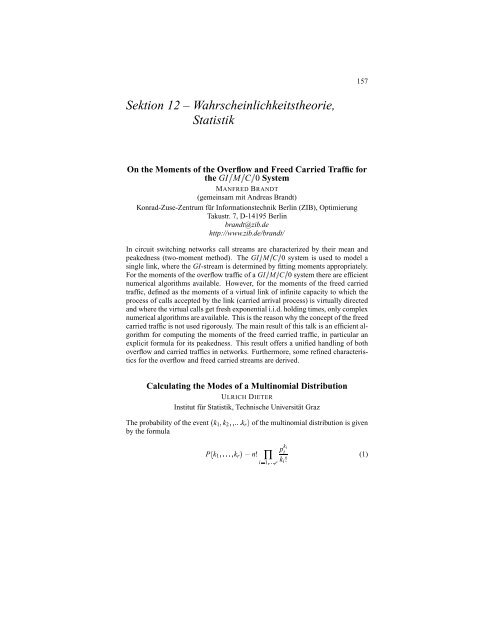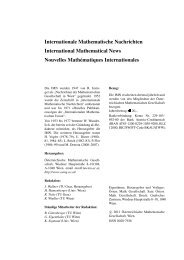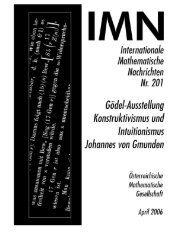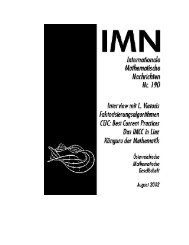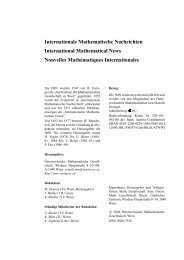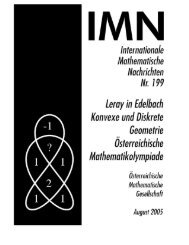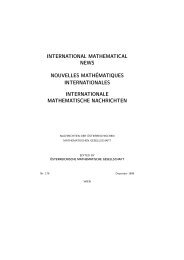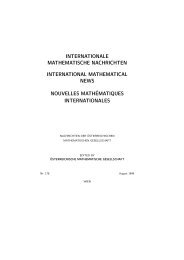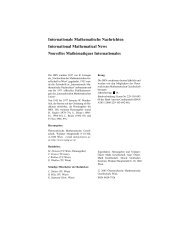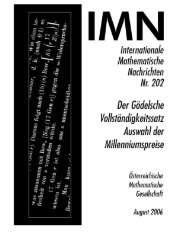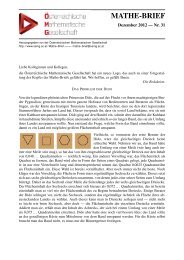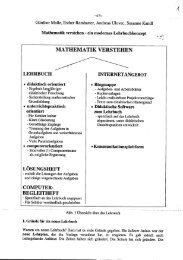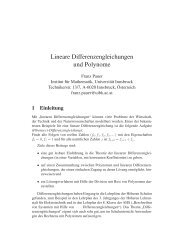Redaktion: K. Sigmund, G. Greschonig (Univ. Wien, Strudlhofgasse ...
Redaktion: K. Sigmund, G. Greschonig (Univ. Wien, Strudlhofgasse ...
Redaktion: K. Sigmund, G. Greschonig (Univ. Wien, Strudlhofgasse ...
Sie wollen auch ein ePaper? Erhöhen Sie die Reichweite Ihrer Titel.
YUMPU macht aus Druck-PDFs automatisch weboptimierte ePaper, die Google liebt.
Sektion 12 – Wahrscheinlichkeitstheorie,<br />
Statistik<br />
On the Moments of the Overflow and Freed Carried Traffic for<br />
the GI¦ M¦ C¦ 0 System<br />
MANFRED BRANDT<br />
(gemeinsam mit Andreas Brandt)<br />
Konrad-Zuse-Zentrum für Informationstechnik Berlin (ZIB), Optimierung<br />
Takustr. 7, D-14195 Berlin<br />
brandt@zib.de<br />
http://www.zib.de/brandt/<br />
157<br />
In circuit switching networks call streams are characterized by their mean and<br />
peakedness (two-moment method). The GI� M� C� 0 system is used to model a<br />
single link, where the GI-stream is determined by fitting moments appropriately.<br />
For the moments of the overflow traffic of a GI� M� C� 0 system there are efficient<br />
numerical algorithms available. However, for the moments of the freed carried<br />
traffic, defined as the moments of a virtual link of infinite capacity to which the<br />
process of calls accepted by the link (carried arrival process) is virtually directed<br />
and where the virtual calls get fresh exponential i.i.d. holding times, only complex<br />
numerical algorithms are available. This is the reason why the concept of the freed<br />
carried traffic is not used rigorously. The main result of this talk is an efficient algorithm<br />
for computing the moments of the freed carried traffic, in particular an<br />
explicit formula for its peakedness. This result offers a unified handling of both<br />
overflow and carried traffics in networks. Furthermore, some refined characteristics<br />
for the overflow and freed carried streams are derived.<br />
Calculating the Modes of a Multinomial Distribution<br />
ULRICH DIETER<br />
Institut für Statistik, Technische <strong>Univ</strong>ersität Graz<br />
The probability of the event � k1� k2��� ����� kr� of the multinomial distribution is given<br />
by the formula<br />
P� k1� ����� � kr��� n! ∏<br />
i� 1�§§§� r<br />
p ki<br />
i<br />
ki!<br />
(1)


